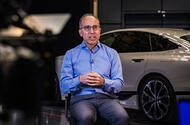What does an aerodynamicist actually do at Audi?
Step into Audi’s wind tunnel in Ingolstadt and you’ll find Dr. Moni Islam at the helm, orchestrating the invisible forces that shape every new Audi. As head of aerodynamics and aeroacoustics, Dr. Islam’s job isn’t just about making cars slice through air more efficiently—it’s about overseeing the entire development process for these disciplines, from the earliest sketches to the moment a car rolls off the production line. His team’s mission? To ensure each Audi isn’t just fast or stylish, but also whisper-quiet and exceptionally efficient.
What does Vorsprung durch Technik mean to the people designing your car?
For Dr. Islam, Audi’s iconic slogan—Vorsprung durch Technik, or progress through technology—isn’t just a catchphrase. It’s a personal challenge. He sees it as the drive to push boundaries, to attempt what others think is impossible. Years ago, his team developed a groundbreaking aerodynamic simulation software that left the industry stunned. The result? Audi became the first to achieve a level of accuracy and flexibility in simulations that competitors thought unattainable. That spirit of innovation is what keeps Audi’s engineers ahead of the curve.
Which Audi models have set new standards for aerodynamics?
If you’re looking for milestones in Audi’s aerodynamic journey, two models stand out. The Audi 100, launched in 1982, and the Audi A2 from 1999. Both were designed with a laser focus on reducing fuel consumption, leading to revolutionary features like streamlined greenhouses, flush glazing, and optimized body trim. The A2, inspired by the work of aerodynamicist Wunibald Kamm, took things even further with its unique proportions and underbody design.
Fast forward to today, and Audi’s electric flagships—the e-tron GT and A6 e-tron—showcase how advanced aerodynamics and bold design can go hand in hand. The e-tron GT uses active components to fine-tune airflow, while the A6 e-tron leverages a host of subtle engineering tweaks to achieve its class-leading efficiency.
How does electrification change the aerodynamic game?
Electric vehicles (EVs) have rewritten the rules for aerodynamicists. With efficiency now a top priority, reducing drag directly translates to longer driving range—a key concern for EV owners. The flat, closed underbodies of EVs are a dream come true for airflow management, and the reduced cooling needs of electric powertrains free up even more design possibilities.
But it’s not all smooth sailing. The hefty batteries in EVs require larger wheels and increase the car’s frontal area, both of which can hurt aerodynamics. Audi’s solution? Collaborate closely with designers to create aero-optimized rims that look as good as they perform. It’s a balancing act between efficiency and aesthetics, and Audi’s latest models prove you don’t have to sacrifice one for the other.
Why should drivers care about aerodynamic efficiency, especially with EVs?
Aerodynamics might sound abstract, but its impact is anything but. For drivers, better aerodynamics means more miles between charges and less energy wasted—especially crucial for EVs. Take the Audi A6 e-tron: its drag coefficient of just 0.21 helps deliver a real-world range of over 750 kilometers. That’s not just a number on a spec sheet; it’s the difference between a stress-free road trip and a hunt for the next charging station.
Audi’s focus on aero isn’t just about range, though. It also means quieter cabins, thanks to meticulous work on aeroacoustics. And by optimizing hidden areas like underbodies and air intakes, Audi’s engineers give designers the freedom to create striking exteriors without compromising efficiency.
How is Audi using technology to stay ahead in aerodynamic design?
Audi’s wind tunnel is more than just a big fan—it’s a high-tech lab that’s set industry standards for decades. It was the first to combine full ground simulation with advanced aeroacoustics, and Audi’s team has built up a unique expertise by running and maintaining the facility themselves.
Recent advances have supercharged their capabilities. Rapid prototyping (think 3D printing) lets engineers quickly test new ideas, while powerful computer simulations—using up to 60,000 processor cores and clocking nearly 300 million CPU-hours last year—allow for thousands of virtual tests before a single part is built. For the A6 e-tron alone, over 3,000 simulations helped fine-tune every curve and crevice.
What makes the Audi A6 e-tron a benchmark for aerodynamics?
The A6 e-tron is Audi’s most aerodynamic car to date, and it’s packed with clever features. The optional virtual wing mirrors, now in their second generation, add up to 7 kilometers of extra range in official tests—and even more on the highway. Active inlet shutters dynamically adjust airflow for optimal cooling and efficiency, while air suspension lowers the car at speed to further cut drag.
But the real secret sauce is in the details. From the rear diffuser to the tire design, every element has been meticulously refined. It’s the cumulative effect of hundreds of small improvements that delivers that standout drag coefficient.
Where is Audi’s aerodynamic innovation headed next?
Looking ahead, Dr. Islam sees Audi pushing even closer to the physical limits of drag reduction, harnessing cutting-edge tools like artificial intelligence and ever-more sophisticated simulations. The goal isn’t just to chase numbers, but to ensure every Audi remains unmistakably an Audi—combining efficiency, performance, and design in a way that feels effortless.
The big takeaway? Aerodynamic excellence isn’t about perfection—it’s about smarter adjustments. Start with one change this week, and you’ll likely spot the difference by month’s end.

